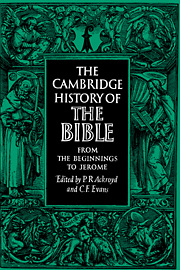Book contents
- Frontmatter
- I LANGUAGE AND SCRIPT
- II BOOKS IN THE ANCIENT WORLD
- 3 BOOKS IN THE ANCIENT NEAR EAST AND IN THE OLD TESTAMENT
- 4 BOOKS IN THE GRAECO-ROMAN WORLD AND IN THE NEW TESTAMENT
- III THE OLD TESTAMENT
- IV THE NEW TESTAMENT
- V THE BIBLE IN THE EARLY CHURCH
- Bibliography
- Abbreviations
- Notes on the Plates
- Indexes
- Plate Section">
- References
3 - BOOKS IN THE ANCIENT NEAR EAST AND IN THE OLD TESTAMENT
from II - BOOKS IN THE ANCIENT WORLD
Published online by Cambridge University Press: 28 March 2008
- Frontmatter
- I LANGUAGE AND SCRIPT
- II BOOKS IN THE ANCIENT WORLD
- 3 BOOKS IN THE ANCIENT NEAR EAST AND IN THE OLD TESTAMENT
- 4 BOOKS IN THE GRAECO-ROMAN WORLD AND IN THE NEW TESTAMENT
- III THE OLD TESTAMENT
- IV THE NEW TESTAMENT
- V THE BIBLE IN THE EARLY CHURCH
- Bibliography
- Abbreviations
- Notes on the Plates
- Indexes
- Plate Section">
- References
Summary
The discovery of more than half a million documents spanning the period of the Old Testament now enables a comparison to be made between the various contemporary literary forms in use within the ancient Near East. Such a study is an essential preliminary to any adequate critical study of the Old Testament, itself a collection of books and writings brought together over many centuries.
MATERIAL FORM
Papyrus
The loss of original or early manuscripts of the Old Testament books is almost certainly due to the use of perishable writing materials. Throughout Palestine the most common may well have been papyrus (Cyperus papyrus L.: Egyptian twfy, called in Hebrew sûp) which grew freely in shallow lakes in Egypt and Syria. Since large quantities were used and transhipped from the Syrian port of Byblos it is surmised that the Greek word for books (τα βιβλια) derives from that place-name though the Greek word for papyrus-reed (hence the English ‘paper’) may itself be of Egyptian origin (‘that of (belonging to) Pharaoh’).
The reeds were stripped and cut lengthwise into thin narrow slices before being beaten and pressed together into two layers set at right angles to each other. When dried the whitish surface was polished smooth with a stone or other implement. Pliny refers to several qualities of papyri and varying thicknesses and surfaces are found before the New Kingdom period when sheets were often very thin and translucent. Though a papyrus sheet was somewhat thicker than modern writing paper it could be rolled easily.
- Type
- Chapter
- Information
- The Cambridge History of the Bible , pp. 30 - 48Publisher: Cambridge University PressPrint publication year: 1970
References
- 2
- Cited by

